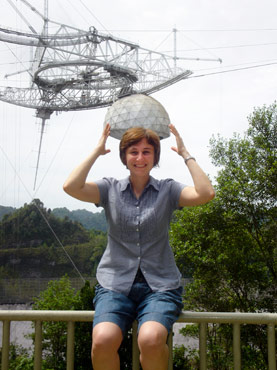Book, research sparked professor’s passion for the gas and dust of the galaxy

Snezana Stanimirovic pretending to hold overhead a massive radio telescope at the Arecibo Observatory in Arecibo, Puerto Rico. Operated by the National Astronomy and Ionosphere Center, the Arecibo Observatory has the largest and most sensitive radio telescope in the world. Photo: Lou Nigra
Most people first think of the stars when thinking about outer space — but Snezana Stanimirovic is more interested in what’s between them.
An assistant professor of astronomy, Stanimirovic ponders the cocktail of gases and dust, called the interstellar medium, that fills the spaces between stars in our and nearby galaxies. She uses radio telescopes — from a small one on the roof of Sterling Hall to the massive one in Arecibo, Puerto Rico — to image the interstellar medium and learn how galactic clouds form and metamorphose into stars, shaping the evolution of galaxies.
Wisconsin Week: How did you first get interested in astronomy?
Stanimirovic: While in elementary school I found Carl Sagan’s “Cosmos” in my local library and this (huge) book sparked my fascination with astronomy. Later I attended a special science center where high school students worked with scientists and univesrsity professors on small research projects like monitoring meteor showers, learning about astrophotography or measuring sunspots. That was my first research experience ever. I loved it and decided to study astronomy.
Wisconsin Week: What do you enjoy most about your work?
Stanimirovic: I really enjoy the constant learning. Every research project is different and the road of exploring new things is full of excitement and challenges. This can be very hard too, as it’s common to encounter dead ends and problems. But looking through the telescope in the middle of the night and waiting for the first spectra to arrive on your computer screen is just breathtaking.
Wisconsin Week: What’s the research question most on your mind right now?
Stanimirovic: I think a lot about how small parcels of cold gas can survive within a much warmer medium, a question at the heart of some of my current research. We have observed clouds of cold gas in the Milky Way similar in size to our solar system, as well as cold clouds immersed in the Milky Way’s million-degree atmosphere. We would expect them to get quickly overwhelmed by the much warmer surrounding medium, but our observations say they are doing just fine and may even be able to make stars.
Wisconsin Week: What about your field or work do you think surprises people the most?
Stanimirovic: It’s always surprising for people to learn how radio telescopes can see parts of the universe that are invisible to the human eye and provide detailed information about more than 100 different molecules that are out there in space.
Wisconsin Week: What outcomes do you see for society from your work?
Stanimirovic: By understanding how the interstellar medium works we are essentially testing various physical processes in highly extreme and diverse environments we can never simulate in laboratories on Earth. Also, questions like “what’s going on out there?” have been stimulating the human mind since the dawn of civilization, making my work a small, but hopefully important, part of humankind’s quest for knowledge.
